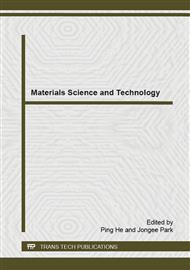p.9
p.15
p.21
p.26
p.32
p.38
p.42
p.49
p.55
Effect of Sintering Time on the Density, Porosity Content and Microstructure of Copper – 1 wt. % Silicon Carbide Composites
Abstract:
In this paper, several copper matrixes reinforced with 1 wt. % silicon carbide (SiC) were fabricated using powder metallurgy (PM). The effect of sintering time (30 min, 60 min, 90 min, and 180 min) on composite density and porosity, and grain size were investigated. The results showed that longer sintering time gives higher sintered density, and smaller porosity content. This is due to the diffusion enhancement, which leads to reduce pore size, and close porosities. Also, for a given compaction pressure, the grains tend to be coarser for longer sintering time, due to the materials tendency to reduce grain boundary surface energy. In addition, samples compacted at high pressure have finer grain than corresponding grains compacted at low pressure but sintered for the same time.
Info:
Periodical:
Pages:
32-37
Citation:
Online since:
December 2014
Keywords:
Price:
Сopyright:
© 2015 Trans Tech Publications Ltd. All Rights Reserved
Share:
Citation:


